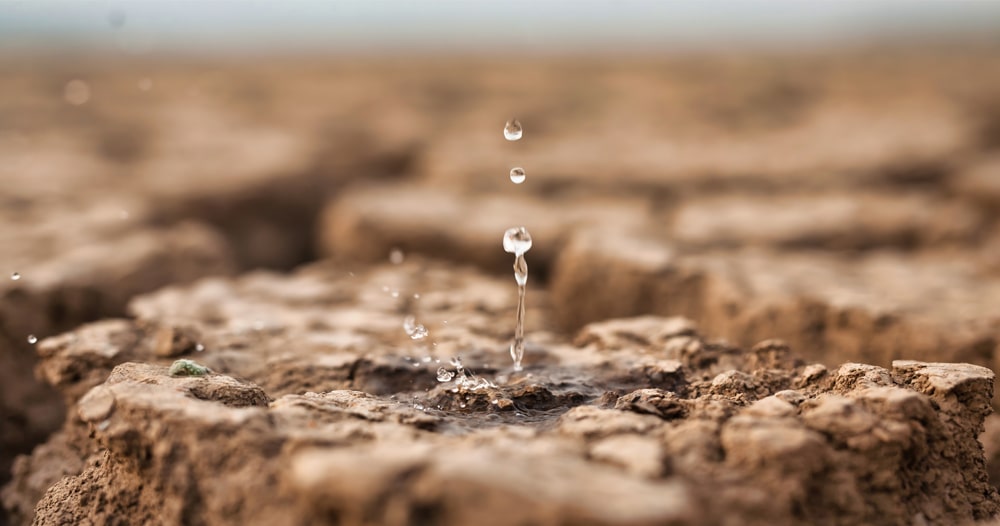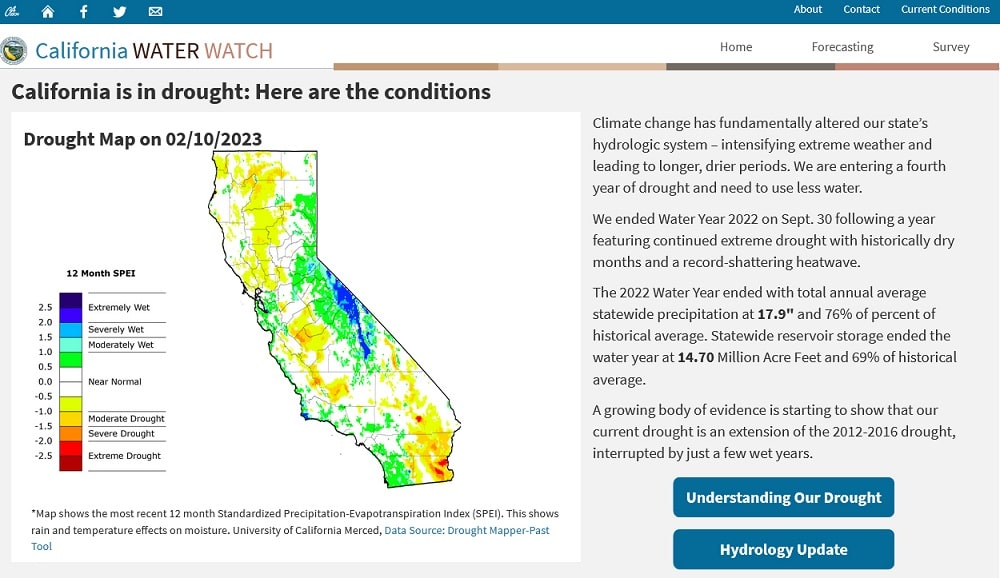
|
|---|
| Home News Contact us |
|
 |

|
|---|
| Home News Contact us |
|
 |

|
|---|
| Home⇨ California 2023: Current drought conditions |
California 2023: Current drought conditions |

California continues to be under the four-year shadow of drought caused by climate change in this region of the United States, exacerbating the state's hydrological system even further. According to the California Water Watch website, the water scarcity problem caused by the drought remains acute this year as well. As this source indicates, precipitation at the end of 2022 amounted to 17.9 inches, which is 76% of the historical average level. Clearly, by the end of 2022, the drought had captured 24% of the state's water resources or almost a quarter. This critical climate change situation has led to a total volume of water reserves in the state's reservoirs at the end of the year, amounting to 14.7 million acre-feet, which is 31% lower than the historical average. According to forecasts, despite some rainy periods, the drought persists and may well become a continuation of the dry period of 2012-2016 The consequences of the drought are not equally felt throughout California. Different residents experience different consequences of the drought depending on where they live and on the source or sources of their water. For instance, farmers who raise livestock on non-irrigated pastures and rural residents who depend on private wells are most vulnerable to the effects of the drought. In contrast, the situation for large urban water agencies that manage numerous water sources is much better because they can withstand several dry years. However, over time, if the drought continues at the same pace as in recent years, all water users in California will experience the consequences of the drought. In addition to water scarcity, the 2022 California drought also led to deteriorating air quality in the region due to increased dust and smoke from wildfires caused by the dry weather. In some California communities, several power outages occurred due to wildfires caused by the drought. For instance, in Shasta County in the northern part of the state, electricity was cut off in October for more than 50,000 homes and businesses due to the risk of fire caused by strong winds and dry weather. Also in October 2022, power outages occurred in some areas of Sonoma and Napa counties in northern California due to fire threats. The decrease in livestock on farms due to food and water shortages has led to the loss of many jobs, which, in turn, has caused the prices of certain food products, such as meat and dairy, to rise. The California drought has caused the decline of the state's largest tourism industry due to water usage restrictions and closure of popular attractions such as Yosemite and Redwood, thereby reducing tourism revenues. As of the publication of this news, 33.4 million people in California have been affected by drought, according to Drought.gov. Additionally, 58 counties in California have received USDA disaster designations due to the drought. It's evident that the climate in California has changed, not only in this region but also throughout the American West, due to hot and dry weather. Further continuation of the dry period over California could result in a 10% loss of the state's water resources by 2040, as stated by scientists. As we can see, the Mediterranean climate of California, with warm and dry summers and mild and wet winters, has been replaced by a climate with low precipitation and high temperatures. The consequences of such a climate in the past four years in California speak for themselves. Therefore, the new climate conditions are a new reality for the entire state, and we must adapt to them. A map of current drought conditions in california 2023 is available on site U.S. Drought Monitor. In 2018, the California Climate Adaptation Strategy was proposed, known officially as "The Safeguarding California Plan: 2018 Update", which outlines measures for adapting to climate change in California by 2040. This strategy was based on research conducted by scientists from various universities and research centers in California, including the:
The strategy includes measures for managing water resources, adapting cities and infrastructure to higher temperatures, reducing the risk of wildfires, protecting ecosystems, and adapting agriculture and industry to new conditions. Specific measures proposed in the strategy include:
However, it should be noted that the adaptation strategy is a conceptual document, and its successful implementation will require significant efforts from the state, cities, businesses, and residents of California. Regarding individual residents of the state, having a direct motivation to live in water abundance, they can do much. For example, they can install water-saving devices in their homes, such as low-flow showerheads, faucet aerators, and dual flush toilets. They can also regularly check pipes for leaks and quickly fix them to avoid unnecessary water losses. Residents of California can also reduce their water footprint in the fight against drought by using less water to produce food and goods they buy, choosing products that are produced in regions with higher rainfall and do not require extensive irrigation. They can also practice gardening using methods that reduce water consumption, such as drip irrigation and mulching. Finally, residents of California can help in the fight against drought by supporting programs and initiatives aimed at improving water resource management in the state: supporting financing and conducting research aimed at developing new technologies for water purification and reuse, as well as supporting organizations and groups that educate residents on water-efficient use and drought prevention. In turn, by addressing the issue of each California resident in the fight against drought, we offer help to everyone in this acute problem of water shortage.
To combat drought, we propose that every resident use WaterAid Drought Solution technology, which allows for more efficient use of available water resources and reduces water consumption. Every resident of California can contribute to the fight against drought by using this technology in their home or business. Moreover, the popularization and use of WaterAid Drought Solution can become one of the key elements of successful implementation of the climate change adaptation strategy in California. |
☑ Thanks to the application of WaterAid Drought Solution, your lawn, garden, golf course, and farm crops will always stay green even during drought conditions, while you save up to 40% on water consumption costs within just 4-8 weeks |
Book a free consultation! |
Phone:E-mail:
|
Contact us now!If you need advice on WaterAid Drought Solution, please use the form. Our consultant will contact you. |
|---|
|